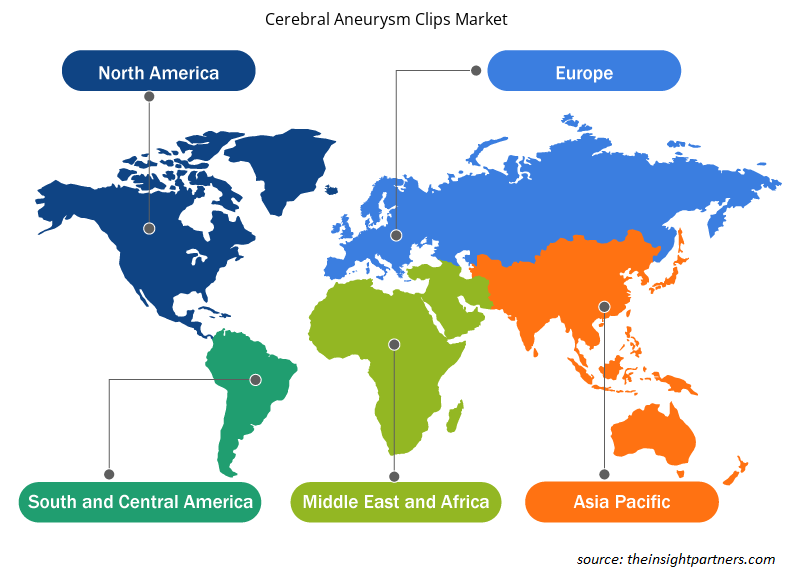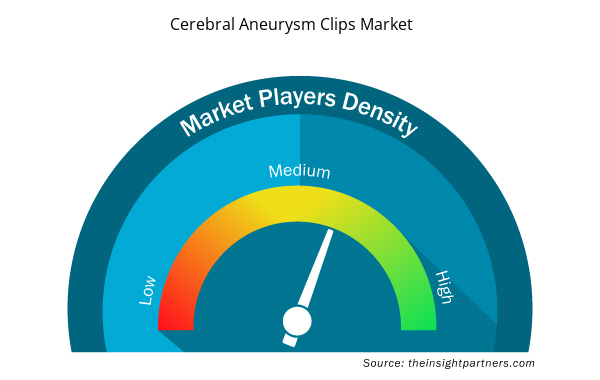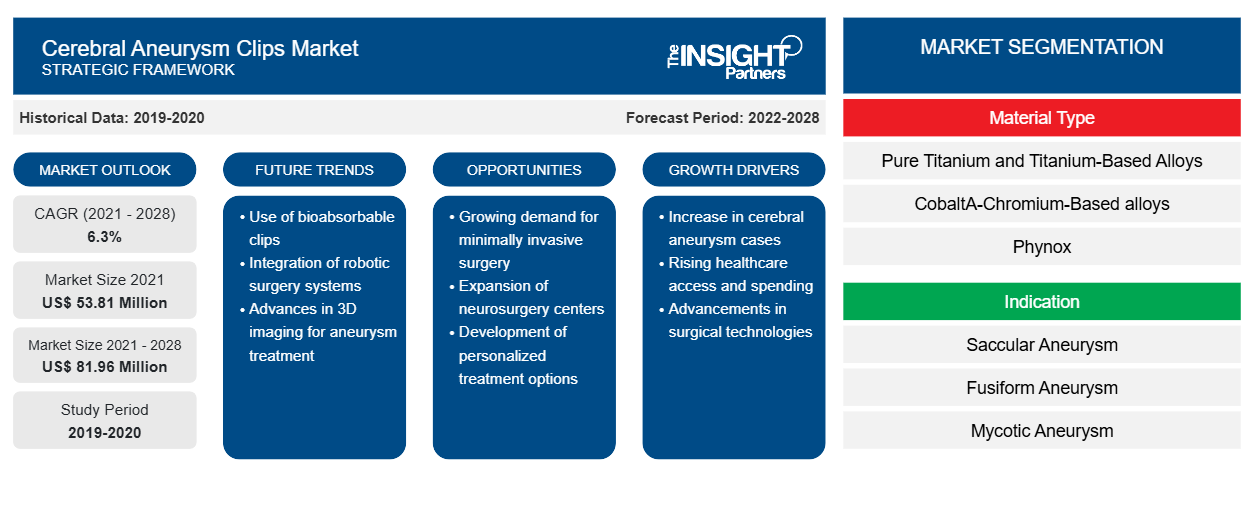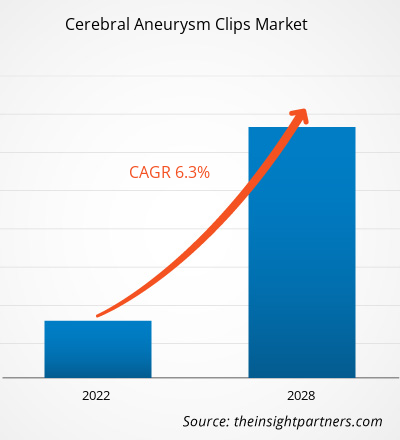Se espera que el mercado de clips para aneurismas cerebrales crezca de US$ 53.810,74 mil en 2021 a US$ 81.960,74 mil en 2028. Se estima que crecerá a una CAGR del 6,3% entre 2022 y 2028.
Un aneurisma cerebral es la formación de una protuberancia en los vasos sanguíneos del cerebro. La protuberancia ejerce presión sobre los nervios o los tejidos cerebrales y su ruptura puede provocar una hemorragia cerebral, que puede ser mortal para el paciente. Factores como las enfermedades genéticas, las malformaciones arteriovenosas, la hipertensión no tratada y el tabaquismo provocan aneurismas cerebrales. El clip microquirúrgico es el método más establecido para tratar los aneurismas. El primer aneurisma tratado mediante clipaje quirúrgico se realizó en el Hospital Johns Hopkins el 23 de marzo de 1937. Durante el clipaje microquirúrgico, se utiliza un pequeño clip metálico para detener el flujo sanguíneo hacia el aneurisma. Se realiza una craneotomía para crear una abertura en el cráneo para llegar al aneurisma. El clip se coloca en el cuello (abertura) del aneurisma para obstruir el flujo sanguíneo y se deja dentro del cerebro después de los procedimientos.
El informe ofrece información y un análisis profundo del mercado global de clips para aneurismas cerebrales , haciendo hincapié en varios parámetros que incluyen tendencias del mercado, avances tecnológicos, dinámica del mercado y análisis del panorama competitivo de los principales actores del mercado global. También incluye el impacto de la pandemia de COVID-19 en el mercado en todas las regiones principales. El mercado de clips para aneurismas cerebrales experimentó el impacto general mixto de la pandemia de COVID-19 y, por lo tanto, el mercado sigue ganando terreno y se espera que crezca en los próximos años. Durante esta emergencia sanitaria, brindar atención médica a todos los pacientes se convirtió en un desafío para los sistemas de atención médica, que se vieron sobrecargados debido a la necesidad de tratar a la gran cantidad de pacientes con COVID. Las empresas de dispositivos médicos también enfrentaron problemas en la gestión de sus operaciones en 2020. Sin embargo, con la relajación gradual de las restricciones sociales y la reanudación de los procedimientos electivos por parte de los hospitales, la demanda de procedimientos quirúrgicos y accesorios relacionados ha vuelto a niveles normales.
Mercado de clips para aneurismas cerebrales -
Personalice este informe según sus necesidades
Obtendrá personalización en cualquier informe, sin cargo, incluidas partes de este informe o análisis a nivel de país, paquete de datos de Excel, así como también grandes ofertas y descuentos para empresas emergentes y universidades.
- Obtenga las principales tendencias clave del mercado de este informe.Esta muestra GRATUITA incluirá análisis de datos, desde tendencias del mercado hasta estimaciones y pronósticos.
Perspectivas basadas en la geografía
Por geografía, el mercado de clips para aneurismas cerebrales está segmentado en América del Norte (EE. UU., Canadá y México), Europa (Francia, Alemania, Reino Unido, España, Rusia, Italia y resto de Europa), Asia Pacífico (China, India, Japón, Australia, Corea del Sur, Kazajstán y resto de Asia Pacífico), Medio Oriente y África (Arabia Saudita, Emiratos Árabes Unidos, Sudáfrica y resto de Medio Oriente y África) y América del Sur y Central (Brasil, Argentina y resto de América del Sur y Central).UAE, South Africa, and Rest of Middle East & Africa), and South & Central America (Brazil, Argentina, and Rest of South & Central America).
Perspectivas del mercado
El aumento de la población geriátrica impulsa el crecimiento del mercado de clips para aneurismas cerebrales
Los aneurismas cerebrales son comunes entre las poblaciones de edad avanzada, lo que hace más evidente la necesidad de imágenes vasculares no invasivas. Las inconsistencias en la esperanza de vida, la disfunción cognitiva, la vasculopatía, las comorbilidades y los riesgos de ruptura asociados con los tratamientos endovasculares y quirúrgicos heterogéneos contribuyen a un aumento en el uso de clips para aneurismas cerebrales. Según un estudio de investigación realizado en la Facultad de Medicina de la Universidad de Maryland en 2021, la proporción de personas de 65 años o más alcanzará el 21% en 2050 desde el 8,1%. Varios estudios de autopsias han correlacionado la mayor prevalencia de aneurismas cerebrales no rotos con el avance de la edad. Inagawa et al. del Hospital Central de la Prefectura de Shimane, Izumo, Japón, examinaron 10.259 autopsias realizadas en Nueva York. Encontraron que la incidencia de aneurismas cerebrales no rotos era más alta en pacientes de 60 años o más, con una prevalencia máxima del 1,2% en personas de 70 años o más. Iwamoto et al., de la Universidad de Kyushu, Fukuoka, Japón, evaluaron 1230 autopsias en Japón y notificaron un aumento general de la prevalencia de aneurismas no rotos con el avance de la edad en las mujeres, con una prevalencia máxima del 14,5 % en mujeres japonesas de 60 a 69 años. Al revisar los estudios de angiografía por resonancia magnética en 8696 adultos japoneses asintomáticos, Harada et al. identificaron aneurismas cerebrales no rotos en el 3,2 % de los casos, y la prevalencia aumentó con la edad tanto en hombres como en mujeres.vasculopathy, comorbidities, and rupture risks associated with heterogenous endovascular and surgical treatments contribute to a surge in the use of cerebral aneurysm clips. As per a research study conducted at the University of Maryland School of Medicine in 2021, the proportion of individuals aged 65 or above will reach 21% by 2050 from 8.1%. Several autopsy studies have correlated the increased prevalence of unruptured cerebral aneurysms with advancing age. Inagawa et al. from Shimane Prefectural Central Hospital, Izumo, Japan, examined 10,259 autopsies performed in New York. They found the incidence of unruptured cerebral aneurysms highest in patients aged 60 and above, with a peak prevalence of 1.2% in people aged 70 and above. Iwamoto et al., Kyushu University, Fukuoka, Japan, assessed 1,230 autopsies in Japan, reporting an overall increased prevalence of unruptured aneurysms with advancing age in women, with a peak prevalence of 14.5% in Japanese women of age 60–69 years. When reviewing magnetic resonance angiography studies in 8,696 asymptomatic Japanese adults, Harada et al. identified unruptured cerebral aneurysms in 3.2% of cases, and the prevalence increased with age in both men and women.
Muchos estudios potenciales han evaluado la ocurrencia de la ruptura de un aneurisma y su conexión con la vejez. El riesgo general de ruptura por paciente-año en la población general es de 0,6 a 1,3%. Otros factores de riesgo pertinentes incluyen antecedentes de hemorragia subaracnoidea (HSA), hipertensión, tabaquismo, aneurismas múltiples y morfología irregular en la población geriátrica. Algunos estudios afirman que el tamaño del aneurisma puede estar relacionado con la edad del paciente. El Estudio de Aneurismas Cerebrales No Rotos de Japón (UCAS Japón) evaluó 6.697 aneurismas cerebrales; el 39,7% de los pacientes de 80 años o más tenían un tamaño de 7 mm, o se encontraron aneurismas más grandes en el 21,4% de los pacientes de 50 a 59 años. Por lo tanto, el manejo ideal de los aneurismas cerebrales en pacientes de edad avanzada ofrece margen para futuros desarrollos y cuidados avanzados. En la actualidad, el tratamiento es individualizado y requiere un conocimiento preciso de la historia natural y del riesgo de rotura, que deben sopesarse frente a las comorbilidades de cada individuo, la esperanza de vida, los riesgos relacionados con el tratamiento y las posibilidades de éxito. Por ello, con el aumento de la población anciana, con una mayor prevalencia de aneurismas, es probable que las empresas del mercado de aneurismas cerebrales aprovechen importantes oportunidades de crecimiento en los próximos años.subarachnoid hemorrhage (SAH), hypertension, smoking, multiple aneurysms, and irregular morphology in the geriatric population. Some studies state that aneurysm size may be related to patient age. The Unruptured Cerebral Aneurysm Study of Japan (UCAS Japan) evaluated 6,697 cerebral aneurysms; 39.7% of patients aged 80 years and above had a size of 7 mm, or larger aneurysms were found in 21.4% of patients of age 50–59 years. Therefore, the ideal management of cerebral aneurysms in elderly patients provides scope for further developments and advanced care. Management is currently individualized, requiring the precise knowledge of natural history and risk of rupture that must be weighed against an individual's comorbidities, life expectancy, treatment-related risks, and success possibilities. Thus, with the growing elderly population, having a greater prevalence of aneurysms, companies in the cerebral aneurysms market are likely to grab significant growth opportunities in the coming years.
Información basada en el tipo de material
Según el tipo de material, el mercado de clips para aneurismas cerebrales se segmenta en titanio puro y aleaciones a base de titanio, aleaciones a base de cobalto y cromo, phynox y otros. En 2021, se prevé que el segmento de titanio puro y aleaciones a base de titanio tenga la mayor participación de mercado; sin embargo, se prevé que el segmento de phynox registre la CAGR más alta del mercado entre 2022 y 2028.
Perspectivas regionales del mercado de clips para aneurismas cerebrales
Los analistas de Insight Partners explicaron en detalle las tendencias y los factores regionales que influyen en el mercado de clips para aneurismas cerebrales durante el período de pronóstico. Esta sección también analiza los segmentos y la geografía del mercado de clips para aneurismas cerebrales en América del Norte, Europa, Asia Pacífico, Oriente Medio y África, y América del Sur y Central.

- Obtenga datos regionales específicos para el mercado de clips para aneurismas cerebrales
Alcance del informe sobre el mercado de clips para aneurismas cerebrales
| Atributo del informe | Detalles |
|---|---|
| Tamaño del mercado en 2021 | US$ 53,81 millones |
| Tamaño del mercado en 2028 | US$ 81,96 millones |
| CAGR global (2021-2028) | 6,3% |
| Datos históricos | 2019-2020 |
| Período de pronóstico | 2022-2028 |
| Segmentos cubiertos | Por tipo de material
|
| Regiones y países cubiertos | América del norte
|
| Líderes del mercado y perfiles de empresas clave |
|
Densidad de actores del mercado de clips para aneurismas cerebrales: comprensión de su impacto en la dinámica empresarial
El mercado de clips para aneurismas cerebrales está creciendo rápidamente, impulsado por la creciente demanda de los usuarios finales debido a factores como la evolución de las preferencias de los consumidores, los avances tecnológicos y una mayor conciencia de los beneficios del producto. A medida que aumenta la demanda, las empresas amplían sus ofertas, innovan para satisfacer las necesidades de los consumidores y aprovechan las tendencias emergentes, lo que impulsa aún más el crecimiento del mercado.
La densidad de actores del mercado se refiere a la distribución de las empresas o firmas que operan dentro de un mercado o industria en particular. Indica cuántos competidores (actores del mercado) están presentes en un espacio de mercado determinado en relación con su tamaño o valor total de mercado.
Las principales empresas que operan en el mercado de clips para aneurismas cerebrales son:
- B. BRAUN MELSUNGEN AG
- INSTRUMENTOS REBSTOCK GMBH
- GRUPO KLS MARTIN
- CORPORACIÓN DE CIENCIAS DE LA VIDA INTEGRA
- ORTO-MEDICAL GMBH
Descargo de responsabilidad : Las empresas enumeradas anteriormente no están clasificadas en ningún orden particular.

- Obtenga una descripción general de los principales actores clave del mercado de clips para aneurismas cerebrales
Perspectivas basadas en indicaciones
Según las indicaciones, el mercado de clips para aneurismas cerebrales se segmenta en aneurisma sacular, aneurisma fusiforme y aneurisma micótico. El segmento de aneurisma sacular tuvo la mayor participación de mercado en 2021; sin embargo, se prevé que el segmento de aneurisma micótico registre la CAGR más alta del mercado entre 2022 y 2028.
Información basada en el usuario final
Según el usuario final, el mercado de clips para aneurismas cerebrales se segmenta en hospitales, centros de neurología, centros de cirugía ambulatoria y otros. El segmento de hospitales tuvo la mayor participación de mercado en 2021; sin embargo, se estima que el segmento de centros de neurología registrará la CAGR más alta del mercado entre 2022 y 2028.
Los actores del mercado de clips para aneurismas cerebrales adoptan estrategias orgánicas, que incluyen el lanzamiento y la expansión de productos, para expandir su presencia y su cartera de productos en todo el mundo. Los actores clave en el mercado son B. Braun Melsungen AG; Peter Lazic GmbH; Mizuho Medical Co. Ltd; Rebstock Instruments GmbH; KLS Martin Group; Integra Lifesciences Corporation; Ortho-Medical GmbH; y Adeor Medical AG.
- Análisis histórico (2 años), año base, pronóstico (7 años) con CAGR
- Análisis PEST y FODA
- Tamaño del mercado Valor/volumen: global, regional, nacional
- Industria y panorama competitivo
- Conjunto de datos de Excel


- Dropshipping Market
- Transdermal Drug Delivery System Market
- Small Internal Combustion Engine Market
- Animal Genetics Market
- Battery Testing Equipment Market
- Hand Sanitizer Market
- Tortilla Market
- Oxy-fuel Combustion Technology Market
- Single Pair Ethernet Market
- Semiconductor Metrology and Inspection Market

Report Coverage
Revenue forecast, Company Analysis, Industry landscape, Growth factors, and Trends

Segment Covered
This text is related
to segments covered.

Regional Scope
North America, Europe, Asia Pacific, Middle East & Africa, South & Central America

Country Scope
This text is related
to country scope.
Preguntas frecuentes
Global cerebral aneurysm clip market is segmented by region into North America, Europe, Asia Pacific, Middle East & Africa, and South & Central America. In North America, the U.S. is the largest market for cerebral aneurysm clips market. The US is estimated to hold the largest share in the cerebral aneurysm clips market during the forecast period. The presence of top players and favorable regulations related to product approvals coupled with the commercialization of new products are the contributing factors to the regional growth. Additionally, the increasing number of technological advancements is the key factor responsible for the Asia-Pacific regional growth for cerebral aneurysm clips accounting fastest growth of the region during the coming years.
The Global cerebral aneurysm clips market, including B. Braun Melsungen AG; Peter Lazic GmbH; Mizuho Medical Co. Ltd; Rebstock Instruments GmbH; KLS Martin Group; Integra Lifesciences Corporation; Ortho-Medical GmbH; Adeor Medical AG and among others.
The Unruptured aneurysm segment dominated the global cerebral aneurysm clip market and accounted for the largest revenue of 47.8 Mn in 2021.
Based on Indication, saccular aneurysm accounts for the largest share in 2021 and is expected to continue to do so till the forecast period.
The more established method of treating aneurysms is microsurgical clipping. The first aneurysm ever treated by surgical clipping was performed at Johns Hopkins Hospital by Dr Walter Dandy on March 23, 1937.
During microsurgical clipping, a small metal clip is used to stop blood flow into the aneurysm. A craniotomy is performed to create an opening in the skull to reach the aneurysm in the brain. The clip is placed on the neck (opening) of the aneurysm to obstruct the flow of blood and remains inside the brain.
Increasing prevalence of brain aneurysms and the rise in research and development activities is one of the most significant factors responsible for the overall market growth.
Trends and growth analysis reports related to Life Sciences : READ MORE..
The List of Companies - Cerebral Aneurysm Clips Market
- B. BRAUN MELSUNGEN AG
- REBSTOCK INSTRUMENTS GMBH
- KLS MARTIN GROUP
- INTEGRA LIFESCIENCES CORPORATION
- ORTHO-MEDICAL GMBH
- MIZUHO AMERICA
- ADEOR MEDICAL AG
- PETER LAZIC GMBH
The Insight Partners performs research in 4 major stages: Data Collection & Secondary Research, Primary Research, Data Analysis and Data Triangulation & Final Review.
- Data Collection and Secondary Research:
As a market research and consulting firm operating from a decade, we have published and advised several client across the globe. First step for any study will start with an assessment of currently available data and insights from existing reports. Further, historical and current market information is collected from Investor Presentations, Annual Reports, SEC Filings, etc., and other information related to company’s performance and market positioning are gathered from Paid Databases (Factiva, Hoovers, and Reuters) and various other publications available in public domain.
Several associations trade associates, technical forums, institutes, societies and organization are accessed to gain technical as well as market related insights through their publications such as research papers, blogs and press releases related to the studies are referred to get cues about the market. Further, white papers, journals, magazines, and other news articles published in last 3 years are scrutinized and analyzed to understand the current market trends.
- Primary Research:
The primarily interview analysis comprise of data obtained from industry participants interview and answers to survey questions gathered by in-house primary team.
For primary research, interviews are conducted with industry experts/CEOs/Marketing Managers/VPs/Subject Matter Experts from both demand and supply side to get a 360-degree view of the market. The primary team conducts several interviews based on the complexity of the markets to understand the various market trends and dynamics which makes research more credible and precise.
A typical research interview fulfils the following functions:
- Provides first-hand information on the market size, market trends, growth trends, competitive landscape, and outlook
- Validates and strengthens in-house secondary research findings
- Develops the analysis team’s expertise and market understanding
Primary research involves email interactions and telephone interviews for each market, category, segment, and sub-segment across geographies. The participants who typically take part in such a process include, but are not limited to:
- Industry participants: VPs, business development managers, market intelligence managers and national sales managers
- Outside experts: Valuation experts, research analysts and key opinion leaders specializing in the electronics and semiconductor industry.
Below is the breakup of our primary respondents by company, designation, and region:

Once we receive the confirmation from primary research sources or primary respondents, we finalize the base year market estimation and forecast the data as per the macroeconomic and microeconomic factors assessed during data collection.
- Data Analysis:
Once data is validated through both secondary as well as primary respondents, we finalize the market estimations by hypothesis formulation and factor analysis at regional and country level.
- Macro-Economic Factor Analysis:
We analyse macroeconomic indicators such the gross domestic product (GDP), increase in the demand for goods and services across industries, technological advancement, regional economic growth, governmental policies, the influence of COVID-19, PEST analysis, and other aspects. This analysis aids in setting benchmarks for various nations/regions and approximating market splits. Additionally, the general trend of the aforementioned components aid in determining the market's development possibilities.
- Country Level Data:
Various factors that are especially aligned to the country are taken into account to determine the market size for a certain area and country, including the presence of vendors, such as headquarters and offices, the country's GDP, demand patterns, and industry growth. To comprehend the market dynamics for the nation, a number of growth variables, inhibitors, application areas, and current market trends are researched. The aforementioned elements aid in determining the country's overall market's growth potential.
- Company Profile:
The “Table of Contents” is formulated by listing and analyzing more than 25 - 30 companies operating in the market ecosystem across geographies. However, we profile only 10 companies as a standard practice in our syndicate reports. These 10 companies comprise leading, emerging, and regional players. Nonetheless, our analysis is not restricted to the 10 listed companies, we also analyze other companies present in the market to develop a holistic view and understand the prevailing trends. The “Company Profiles” section in the report covers key facts, business description, products & services, financial information, SWOT analysis, and key developments. The financial information presented is extracted from the annual reports and official documents of the publicly listed companies. Upon collecting the information for the sections of respective companies, we verify them via various primary sources and then compile the data in respective company profiles. The company level information helps us in deriving the base number as well as in forecasting the market size.
- Developing Base Number:
Aggregation of sales statistics (2020-2022) and macro-economic factor, and other secondary and primary research insights are utilized to arrive at base number and related market shares for 2022. The data gaps are identified in this step and relevant market data is analyzed, collected from paid primary interviews or databases. On finalizing the base year market size, forecasts are developed on the basis of macro-economic, industry and market growth factors and company level analysis.
- Data Triangulation and Final Review:
The market findings and base year market size calculations are validated from supply as well as demand side. Demand side validations are based on macro-economic factor analysis and benchmarks for respective regions and countries. In case of supply side validations, revenues of major companies are estimated (in case not available) based on industry benchmark, approximate number of employees, product portfolio, and primary interviews revenues are gathered. Further revenue from target product/service segment is assessed to avoid overshooting of market statistics. In case of heavy deviations between supply and demand side values, all thes steps are repeated to achieve synchronization.
We follow an iterative model, wherein we share our research findings with Subject Matter Experts (SME’s) and Key Opinion Leaders (KOLs) until consensus view of the market is not formulated – this model negates any drastic deviation in the opinions of experts. Only validated and universally acceptable research findings are quoted in our reports.
We have important check points that we use to validate our research findings – which we call – data triangulation, where we validate the information, we generate from secondary sources with primary interviews and then we re-validate with our internal data bases and Subject matter experts. This comprehensive model enables us to deliver high quality, reliable data in shortest possible time.


 Obtenga una muestra gratuita de este informe
Obtenga una muestra gratuita de este informe